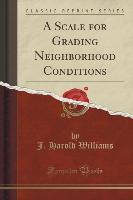A Scale for Grading Neighborhood Conditions (Classic Reprint)
BücherAngebote / Angebote:
Excerpt from A Scale for Grading Neighborhood Conditions
Another boy was reported to be "living" in a neighborhood with bad environment. Our investigation showed the home to have an index of 10, and the neighborhood index to be 9, both relatively low, as expected, but much more clearly understood because of the application of a systematic method of grading.
In some cases our grading is not in such close agreement with the report of the probation officer as in the cases just referred to. This is not often due to differences in accuracy of observation, but to the inadequacy of such terms as "good, " "bad, " "fair, " "poor, " etc., for comparative purposes. The application of a uniform scale minimizes the need for using descriptive adjectives in stating general conditions. Our inquiries have led to the belief that the home and neighborhood grading scales furnish reliable means for expressing the conditions which they are intended to classify.
Method Of Grading Neighborhoods
As in the grading of homes, a personal visit is required to obtain reliable data for grading neighborhoods. Both home and neighborhood, in most of our cases, are graded from data secured at the same time. The field-worker makes a careful inspection in the vicinity of the home, notes the location, the approximate number of homes, the relative density of the population, the relative number of children, and other significant points. While the points just mentioned are not graded, they are of importance for both comparative and interpretative purposes. These are recorded on the individual score card with the graded data. (See samples in Fig. 2).
The neighborhood is graded upon the basis of five items, as follows: T, neatness, sanitation, and improvements, II, playground facilities, III, institutions and establishments, IV, social status of residents, V, average grade of homes. Each item is graded on a scale of five points, 1 point representing decidedly unfavorable conditions, 5 points representing favorable conditions, and 2, 3 and 4 representing conditions of varying favorability between the two extremes. The standard score card (show. in tentative form in Fig.1) contains samples of data descriptive of actual neighborhood conditions for each item, which grade 1 point, 3 points, and 5 points respectively.
About the Publisher
Forgotten Books publishes hundreds of thousands of rare and classic books. Find more at www.forgottenbooks.com
This book is a reproduction of an important historical work. Forgotten Books uses state-of-the-art technology to digitally reconstruct the work, preserving the original format whilst repairing imperfections present in the aged copy. In rare cases, an imperfection in the original, such as a blemish or missing page, may be replicated in our edition. We do, however, repair the vast majority of imperfections successfully, any imperfections that remain are intentionally left to preserve the state of such historical works.
Folgt in ca. 5 Arbeitstagen

